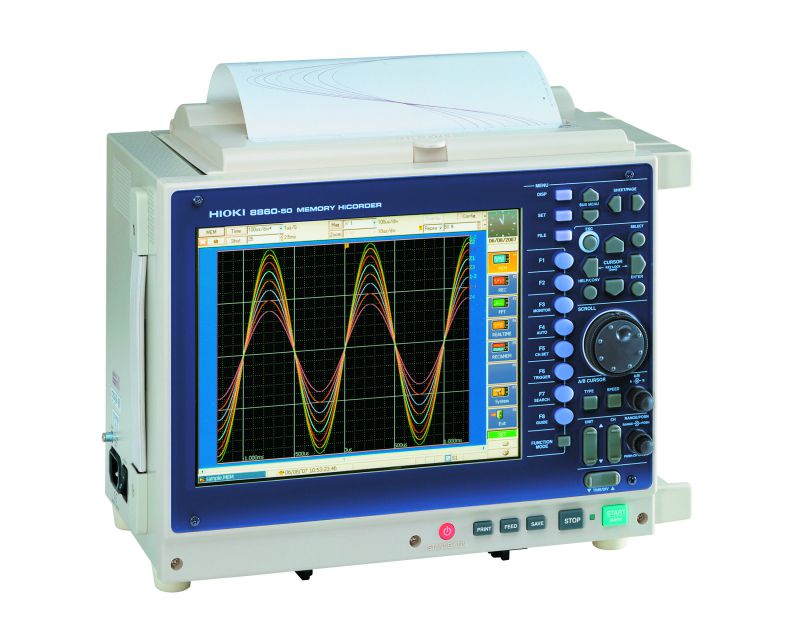Imagine being able to monitor 28 motors for a seamless steel pipe manufacturing process from a single benchtop device with peripherals. This is what one manufacturer is doing with a HIOKI 8861-50 32-channel oscilloscope.
The plant manufactures steel pipes for conveyors that transport steel sheets in a rolling process. The company was planning a large scale upgrade of the pipe manufacturing facility and needed to observe the exact conditions of a facility employing a total of 28 motors.
The conveyor is several tens of metres in length. The 8861-50 monitors the operating conditions of all of the motors and saves the real time traces for tests that are conducted over several days at a time.
The Hioki 8860-50 has 32 completely isolated analogue channels and can be configured to have up to 128 channels using an optional input module. Designed for bench use, the 8860-51 includes a full colour screen interface of adjustment tools and supports keyboard and mouse input using the USB ports. It also has a built-in fast CPU, ensuring superior monitoring and waveform capturing directly to the instrument’s built-in memory.
The recorder features 20MS/s high speed sampling and data acquisition for high speed real-time recording, as well as Fast Fourier Transform (FFT) frequency analysis.
Power Quality Analysis
Aside from being controlled, motors may also need monitoring for power quality problems and this may be performed from a benchtop or handheld analyser.
Power disturbances may be in the form of voltage sags, swells, imbalances, transients, interruptions and harmonics, which can cause problems ranging from malfunctioning of equipments to complete plant shutdowns. Voltage sag and harmonics are the main cause of malfunctioning or tripping of equipment.
A voltage sag condition implies that the voltage on one or more phases drops below the specified tolerance for a short period of time, typically from a half cycle to one minute, typically manifesting itself as controller faults and system crashes, or dropped or damaged relay coils.
Harmonics and noise is a stray voltage or current caused by factors such as non-linear electric loads leading to overheating, failure of electronic equipment, incorrect readings on meters and faulty operation of protective relays.
For benchtop analysis, the Hioki 3193-10 Power Analyser provides six separate measurement channels with wide spectrum detail, for example in order to measure the inputs and outputs of three-phase inverters so as to determine their impact on power quality. It can also carry out flicker and harmonic measurements.
Measurements are shown on the 3193-10’s wide-angle high visibility colour LCD screen. Multiple measurements can be shown simultaneously to make it easier to interpret measurement results in real time. As standard this tester comes with RS-232C and GP-IB interfaces for PC connection.
For portability, the Hioki 3197 Power Quality Analyser provides comprehensive power management tools in handheld form. It is suitable for monitoring inrush current, voltage swells, voltage dips, transient overvoltage and interruptions to measuring and recording power and power factor, active/reactive energy, demand, load changes and voltage/current.
Featuring a full colour LCD screen, the analyser can display multiple values simultaneously complete with waveform display and other information. Data can be recorded on the instrument’s recordable memory and can be downloaded to PC via USB connection.
Calibration
Calibration manuals are available for download from the Hioki website for both the 8861-50 Oscilloscope and the 3197 Power Quality Analyser. For the former, the required equipment includes a function generator, digital multitester, frequency counter, metal linear scale, protractor, single-channel and four-channel input modules, printer, memory storage, disk storage, DC power unit, probe power unit, memory backup unit and PC.
Equipment may be rented to calibrate the oscilloscope on-site but a more viable option is to have it calibrated at a professional United Kingdom Accreditation Service (UKAS) calibration laboratory like calibrate.co.uk. UKAS is recognised by the British government for assessing the competence of organisations that provide calibration services against internationally agreed standards.
All accredited calibrations must comply with the quality system standards set out in the BS EN ISO/IEC 17025:2005 General requirements for the competence of testing and calibration laboratories.
The advantages of using a UKAS accredited laboratory include proven traceability to national standards. All calibrations are conducted by able calibration technicians and approved signatories who are regularly inspected by the UKAS assessors.
And the customer is assured that their equipment is properly maintained to their scope of accreditation providing accurate measurement and generation capability.



